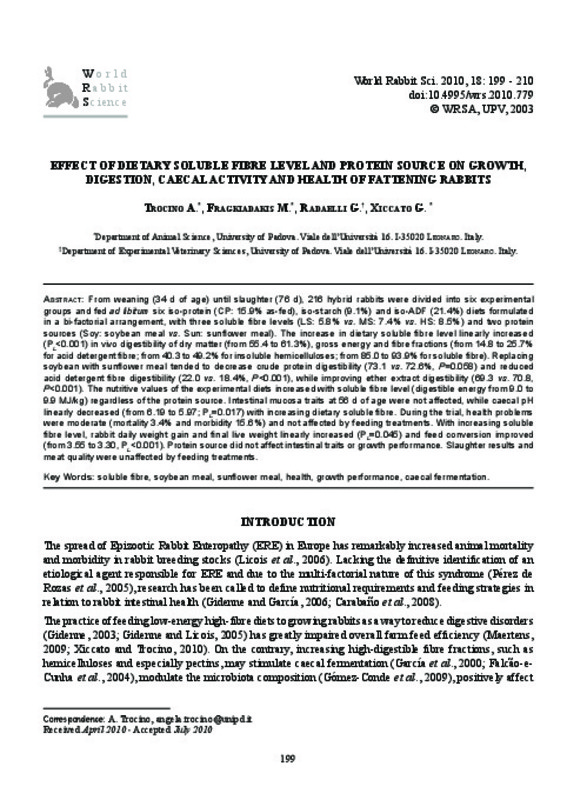JavaScript is disabled for your browser. Some features of this site may not work without it.
Buscar en RiuNet
Listar
Mi cuenta
Estadísticas
Ayuda RiuNet
Admin. UPV
Effect of dietary soluble fibre level and protein source on growth, digestion, caecal activity and health of fattening rabbits
Mostrar el registro sencillo del ítem
Ficheros en el ítem
| dc.contributor.author | Trocino, Angela
|
|
| dc.contributor.author | Fragkiadakis, M.
|
|
| dc.contributor.author | Radaelli, G.
|
|
| dc.contributor.author | Xiccato, Gerolamo
|
|
| dc.date.accessioned | 2011-01-12T16:49:03Z | |
| dc.date.available | 2012-12-12T23:30:21Z | |
| dc.date.issued | 2010-12-30 | |
| dc.identifier.issn | 1257-5011 | |
| dc.identifier.uri | http://hdl.handle.net/10251/9141 | |
| dc.description.abstract | [EN] From weaning (34 d of age) until slaughter (76 d), 216 hybrid rabbits were divided into six experimental groups and fed ad libitum six iso-protein (CP: 15.9% as-fed), iso-starch (9.1%) and iso-ADF (21.4%) diets formulated in a bi-factorial arrangement, with three soluble fibre levels (LS: 5.8% vs. MS: 7.4% vs. HS: 8.5%) and two protein sources (Soy: soybean meal vs. Sun: sunflower meal). The increase in dietary soluble fibre level linearly increased (PL<0.001) in vivo digestibility of dry matter (from 55.4 to 61.3%), gross energy and fibre fractions (from 14.8 to 25.7% for acid detergent fibre; from 40.3 to 49.2% for insoluble hemicelluloses; from 85.0 to 93.9% for soluble fibre). Replacing soybean with sunflower meal tended to decrease crude protein digestibility (73.1 vs. 72.6%, P=0.058) and reduced acid detergent fibre digestibility (22.0 vs. 18.4%, P<0.001), while improving ether extract digestibility (69.3 vs. 70.8, P<0.001). The nutritive values of the experimental diets increased with soluble fibre level (digestible energy from 9.0 to 9.9 MJ/kg) regardless of the protein source. Intestinal mucosa traits at 56 d of age were not affected, while caecal pH linearly decreased (from 6.19 to 5.97; PL=0.017) with increasing dietary soluble fibre. During the trial, health problems were moderate (mortality 3.4% and morbidity 15.6%) and not affected by feeding treatments. With increasing soluble fibre level, rabbit daily weight gain and final live weight linearly increased (PL=0.045) and feed conversion improved (from 3.55 to 3.30, PL<0.001). Protein source did not affect intestinal traits or growth performance. Slaughter results and meat quality were unaffected by feeding treatments. | es_ES |
| dc.description.sponsorship | The present study was funded by MIUR (PRIN 2005 – Prot. 2005070702). The authors wish to thank Dr. Andrea Zuffellato (Veronesi Verona S.p.A.) for his technical assistance during the trial. | |
| dc.language | Inglés | es_ES |
| dc.publisher | World Rabbit Science. ICTA. UPV | es_ES |
| dc.relation.ispartof | World Rabbit Science | |
| dc.rights | Reserva de todos los derechos | es_ES |
| dc.subject | Soybean meal | es_ES |
| dc.subject | Health | es_ES |
| dc.subject | Growth performance | es_ES |
| dc.subject | Caecal fermentation | es_ES |
| dc.subject | Soluble fibre | es_ES |
| dc.subject | Sunflower meal | es_ES |
| dc.title | Effect of dietary soluble fibre level and protein source on growth, digestion, caecal activity and health of fattening rabbits | es_ES |
| dc.type | Artículo | es_ES |
| dc.identifier.doi | 10.4995/wrs.2010.779 | |
| dc.relation.projectID | info:eu-repo/grantAgreement/MIUR//2005070702/ | |
| dc.rights.accessRights | Abierto | es_ES |
| dc.description.bibliographicCitation | Trocino, A.; Fragkiadakis, M.; Radaelli, G.; Xiccato, G. (2010). Effect of dietary soluble fibre level and protein source on growth, digestion, caecal activity and health of fattening rabbits. World Rabbit Science. 18(4):199-210. https://doi.org/10.4995/wrs.2010.779 | es_ES |
| dc.relation.publisherversion | https://doi.org/10.4995/wrs.2010.779 | |
| dc.description.upvformatpinicio | 199 | |
| dc.description.upvformatpfin | 210 | |
| dc.description.volume | 18 | |
| dc.description.issue | 4 | |
| dc.identifier.eissn | 1989-8886 | |
| dc.contributor.funder | Ministero dell'Istruzione dell'Università e della Ricerca, Italia |








